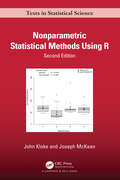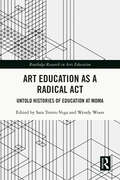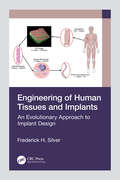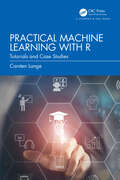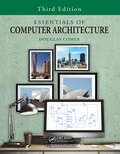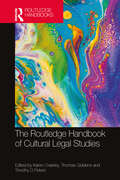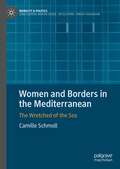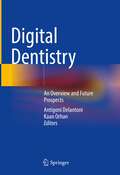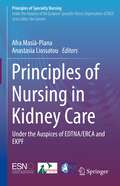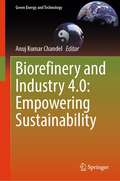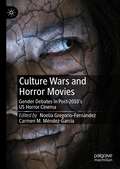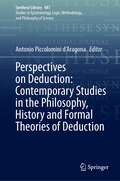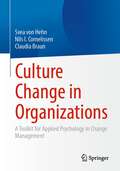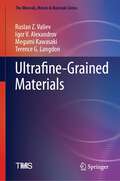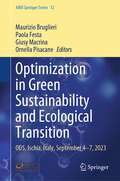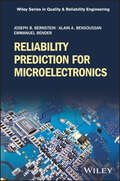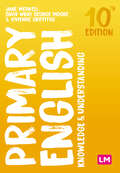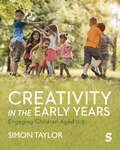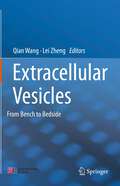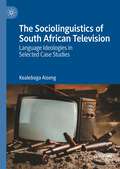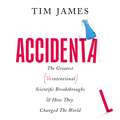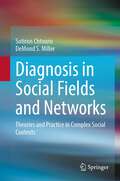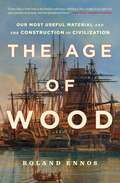- Table View
- List View
Nonparametric Statistical Methods Using R (Chapman & Hall/CRC Texts in Statistical Science #25)
by John Kloke Joseph McKeanPraise for the first edition:“This book would be especially good for the shelf of anyone who already knows nonparametrics, but wants a reference for how to apply those techniques in R.”-The American StatisticianThis thoroughly updated and expanded second edition of Nonparametric Statistical Methods Using R covers traditional nonparametric methods and rank-based analyses. Two new chapters covering multivariate analyses and big data have been added. Core classical nonparametrics chapters on one- and two-sample problems have been expanded to include discussions on ties as well as power and sample size determination. Common machine learning topics --- including k-nearest neighbors and trees --- have also been included in this new edition.Key Features: Covers a wide range of models including location, linear regression, ANOVA-type, mixed models for cluster correlated data, nonlinear, and GEE-type. Includes robust methods for linear model analyses, big data, time-to-event analyses, timeseries, and multivariate. Numerous examples illustrate the methods and their computation. R packages are available for computation and datasets. Contains two completely new chapters on big data and multivariate analysis. The book is suitable for advanced undergraduate and graduate students in statistics and data science, and students of other majors with a solid background in statistical methods including regression and ANOVA. It will also be of use to researchers working with nonparametric and rank-based methods in practice.
Art Education as a Radical Act: Untold Histories of Education at MoMA (Routledge Research in Arts Education)
by Sara Torres-Vega Wendy WoonThis comprehensive volume highlights and centers untold histories of education at the Museum of Modern Art (MoMA) from 1937 to 2020, using the critical voices of artists, scholars, designers, and educators. Exploring these histories as transformative and paradigm-shifting in museum education, it elevates MoMA educators as vocal advocates for harnessing the educational power that museums inherently possess.Divided into three interlinked parts, the first sheds light on the early educational endeavors of the museum while analyzing the context of art education in the United States. The second part focuses on the tenures of Victor D’Amico and Betty Blayton, utilizing the MoMA archives as a primary resource. It includes essays by Ellen Winner, Luis Camnitzer, Susan E. Cahan, Michelle Millar Fisher, HECTOR (Jae Shin & Damon Rich), Gregory Sholette, Carol Duncan, Moreen Maser, Nana Adusei-Poku, Carmen Mörsch, Rika Burnham, Donna M. Jones, and José Ortiz. The third part presents the perspectives of William Burback, Philip Yenawine, Patterson Sims, Deborah F. Schwartz, and Wendy Woon as former MoMA Directors of Education in their own words and considers the forces that shaped their work. This timely and unique exploration ultimately aims to trace and understand the fundamental and evolving concerns of a seemingly underexamined profession constantly striving to maintain relevance in an environment marked by institutional, social, and political uncertainty. Exploring the radical acts undertaken to keep the museum true to its original promise, it delineates the paradox whereby education is both central and invisible to the identity of MoMA and museums more broadly and re-centers the conception of the museum as an educational institution.It is designed for scholars, researchers, and post-graduate students interested in arts education, visual literacy, museum studies, and communication studies.
Engineering of Human Tissues and Implants: An Evolutionary Approach to Implant Design
by Frederick H. SilverThis text presents information on biological control systems, mechanotransduction, tissue structure, and function, as well as properties that can be integrated together to provide improved implant and device designs. This information is needed to develop new diagnostic tests and instruments that provide early diagnostic tests and treatments for diseases.Engineering of Human Tissues and Implants: An Evolutionary Approach to Implant Design provides basic scientific information on the evolutionary design of tissues and organs that are a result of living in a gravitational field. Much of the useful information that is available for the design of implants is based on tissue structure and function derived from light and electron microscopy observations. However, this information is not enough for developing new designs of implants and medical devices since much of the biological response to implants is based on understanding the biological control systems and mechanotransduction that drive many of the responses seen with implanted devices. The book also introduces mechanotransduction as it relates to implant design with an overview of materials and their use in applications that include those materials designed to treat wounds, burns, facial, hernial, ophthalmic, oral, cardiovascular, and tendon/ligaments.This book is intended for biomedical science and engineering students who are learning about artificial implants and medical device development. It will also be of significance to other engineering majors interested in the design of devices for diagnoses and measuring of physiological parameters, as well as to clinicians and researchers who are interested in mechanobiology.
Practical Machine Learning with R: Tutorials and Case Studies
by Carsten LangeThis textbook is a comprehensive guide to machine learning and artificial intelligence tailored for students in business and economics. It takes a hands-on approach to teach machine learning, emphasizing practical applications over complex mathematical concepts. Students are not required to have advanced mathematics knowledge such as matrix algebra or calculus.The author introduces machine learning algorithms, utilizing the widely used R language for statistical analysis. Each chapter includes examples, case studies, and interactive tutorials to enhance understanding. No prior programming knowledge is needed. The book leverages the tidymodels package, an extension of R, to streamline data processing and model workflows. This package simplifies commands, making the logic of algorithms more accessible by minimizing programming syntax hurdles. The use of tidymodels ensures a unified experience across various machine learning models.With interactive tutorials that students can download and follow along at their own pace, the book provides a practical approach to apply machine learning algorithms to real-world scenarios.In addition to the interactive tutorials, each chapter includes a Digital Resources section, offering links to articles, videos, data, and sample R code scripts. A companion website further enriches the learning and teaching experience: https://ai.lange-analytics.com.This book is not just a textbook; it is a dynamic learning experience that empowers students and instructors alike with a practical and accessible approach to machine learning in business and economics. Key Features: Unlocks machine learning basics without advanced mathematics — no calculus or matrix algebra required. Demonstrates each concept with R code and real-world data for a deep understanding — no prior programming knowledge is needed. Bridges the gap between theory and real-world applications with hands-on interactive projects and tutorials in every chapter, guided with hints and solutions. Encourages continuous learning with chapter-specific online resources—video tutorials, R-scripts, blog posts, and an online community. Supports instructors through a companion website that includes customizable materials such as slides and syllabi to fit their specific course needs.
Essentials of Computer Architecture
by Douglas ComerThis easy-to-read textbook provides an introduction to computer architecture, focusing on the essential aspects of hardware that programmers need to know. Written from a programmer’s point of view, Essentials of Computer Architecture, Third Edition, covers the three key aspects of architecture: processors, physical and virtual memories, and input-output (I/O) systems.This third edition is updated in view of advances in the field. Most students only have experience with high-level programming languages, and almost no experience tinkering with electronics and hardware. As such, this text is revised to follow a top-down approach, moving from discussions on how a compiler transforms a source program into binary code and data, to explanations of how a computer represents data and code in binary.Additional chapters cover parallelism and data pipelining, assessing the performance of computer systems, and the important topic of power and energy consumption. Exclusive to this third edition, a new chapter explains multicore processors and how coherence hardware provides a consistent view of the values in memory even though each core has its own cache.Suitable for a one-semester undergraduate course, this clear, concise, and easy-to-read textbook offers an ideal introduction to computer architecture for students studying computer programming.
The Routledge Handbook of Cultural Legal Studies
by Karen Crawley Thomas Giddens Timothy D PetersThis handbook provides a comprehensive introduction to the cutting-edge field of cultural legal studies.Cultural legal studies is at the forefront of the legal discipline, questioning not only doctrine or social context, but how the concerns of legality are distributed and encountered through a range of material forms. Growing out of the interdisciplinary turn in critical legal studies and jurisprudence that took place in the latter quarter of the 20th century, cultural legal studies exists at the intersection of a range of traditional disciplinary areas: legal studies, cultural studies, literary studies, jurisprudence, media studies, critical theory, history, and philosophy. It is an area of study that is characterised by an expanded or open-ended conception of what ‘counts’ as a legal source, and that is concerned with questions of authority, legitimacy, and interpretation across a wide range of cultural artefacts. Including a mixture of established and new authors in the area, this handbook brings together a complex set of perspectives that are representative of the current field, but which also address its methods, assumptions, limitations, and possible futures.Establishing the significance of the cultural for understanding law, as well as its importance as a potential site for justice, community, and sociality in the world today, this handbook is a key reference point both for those working in the cultural legal context – in legal theory, law and literature, law and film/television, law and aesthetics, cultural studies, and the humanities generally – as well as others interested in the interactions between authority, culture, and meaning.
Women and Borders in the Mediterranean: The Wretched of the Sea (Mobility & Politics)
by Camille SchmollThis book offers a history of migration in the Mediterranean written about and from the perspective of women. It gives a complex picture of individual journeys of migrant women, and in a radical departure from the miserabilist or culturalist approach through which women are usually viewed, the book argues for a politically and socially aware, activist feminism that is attuned to what border-obsessed migration policies actually do to women.The research presented in this book is based on multi-sited fieldwork that led the author to closely follow migration survivors. The book depicts the journey of women as they experience brutal separations, have to make heart-wrenching decisions and end up wandering from one place to another, but also as they make acquaintances and find new opportunities. The first-person accounts collected here demonstrate that the reasons behind these women’s decision to leave are anything but simple and linear: they combine various forms of persecution and oppression, a desire for autonomy and a yearning for new horizons, as well as changes in gender relations in their countries of origin.The book further explores the daily lives of women in reception centres, where they are in limbo, their journey as if “suspended,” as they wait for this Europe rejecting them to acknowledge their presence. These women live on and “in” the border – a border that relentlessly haunts them and pursues them everywhere they go. Boredom is constant and, likewise, racism and marginalisation processes are pervasive. At the same time, this study shows that these women are also resisting, strategising, taking charge of their own destinies and journeys, and looking for a way out.Written from the standpoint of a geographer, this study accordingly puts the space of everyday life front and centre. Such a space acts as an impediment to these women’s journeys: it generates a “moralscape” of waiting, which plays a key role in these women’s daily lives.However, it can also help these women gain greater autonomy, thus empowering them, and it may be subverted through various tactics and stratagems, which sometimes take the form of spatialised strategies.
Digital Dentistry: An Overview and Future Prospects
by Antigoni Delantoni Kaan OrhanThis book focuses on recent technological advances in digital dentistry. It provides information on digital aspects in all dental fields including digital caries detection systems, digital color matching, and digital applications in periodontology, surgical implant placement, oral histopathology and pediatric dentistry. Training in emerging and new digital techniques is inevitable in the dental profession. This book contains detailed digital procedures, their basics and their applications. It is divided into three parts: Basic Digital Systems in Dentistry, Novelties and Advances in Digital Dentistry, The Future of Digital Dentistry and Applications. Readers will learn about Artificial Intelligence in dentistry, tissue engineering applications and dental education tools in digital dentistry. The book is a must have for all dental practitioners who would like to deepen their knowledge and understanding of digital systems in dentistry.
Principles of Nursing in Kidney Care: Under the Auspices of EDTNA/ERCA and EKPF (Principles of Specialty Nursing)
by Afra Masià-Plana Anastasia LiossatouThis textbook, endorsed by EDTNA/ERCA and ESNO, provides unique evidence-based knowledge about nursing in renal care and harmonises specialised understandings from various countries, to be implemented across numerous national health systems. Renal care nursing is essential in order to promote and prevent renal health as well as detect and contribute to the care of renal disease. These complex tasks require specialised knowledge and training to ensure patient safety and positive outcomes in patient care. This book describes in detail the highest quality practices in different stages of the disease. Twenty-three chapters reflect evidence-based or consensus in practise, covering management and treatment in patient centred care procedures. Combining expert knowledge from many countries, this textbook can be used for teaching new staff in renal care as well as reviewing and updating renal care expertise. Technological developments have significantly expanded in recent years. In this context renal nurses are responsible not only for individualised, comprehensive, and complex patient care, but also advanced technical skills such as haemodialysis treatment, which require close monitoring of patients to ensure safety. Infection prevention and control is vital throughout patient care. In addition, advanced renal nursing skills have been established for the assessment and management of renal disease. The textbook is unique as in one single volume there is evidence, up to date and rigorous data describing different types of renal care therefore it is possible to concept a holistic vision of CKD patients as well as the nursing perspective.
Biorefinery and Industry 4.0: Empowering Sustainability (Green Energy and Technology)
by Anuj Kumar ChandelThis book provides a comprehensive overview of the latest advances in the production of low carbon chemicals and biofuels from renewable feedstock, including pilot, demo, and commercial-scale technologies. It highlights the role of Industry 4.0 in improving the efficiency and affordability of biorefineries, ultimately leading to the production of bio-based molecules and energy with low carbon and water footprints. Drawing on the expertise of established researchers, academics, and engineers, the book presents a range of informative chapters on the subject. It explores the key elements of Industry 4.0, such as, interconnectivity and smart process automation, and shows how these can be harnessed to revolutionize industrial processes and offer finished products in a cost-effective manner. With its emphasis on sustainability and cutting-edge technology, this book is an essential resource for anyone interested in the future of low carbon chemistry and bioenergy production.
Culture Wars and Horror Movies: Gender Debates in Post-2010’s US Horror Cinema
by Noelia Gregorio-Fernández Carmen M. Méndez-GarcíaNavigating a polarized society in their representation of social values, twenty-first-century horror films critically frame conflicting and divisive ideological issues. Culture Wars and Horror Movies: Gender Debates in post-2010 US Horror Cinema analyses the ways in which these “culture wars” make their way into gender, focusing on the post-2010 US context and its fundamental political divisions.Approaching these topics from feminist and postfeminist theories to ecocritical views, this volume explores how contemporary horror movies engage with the current context of “culture wars.”
Perspectives on Deduction: Contemporary Studies in the Philosophy, History and Formal Theories of Deduction (Synthese Library #481)
by Antonio Piccolomini D'AragonaThis book provides philosophers and logicians with a broad spectrum of views on contemporary research on the problem of deduction, its justification and explanation. The variety of distinct approaches exemplified by the single chapters allows for a dialogue between perspectives that, usually, barely communicate with each other.The contributions concern (in a possibly intertwined way) three major perspectives in logic: philosophical, historical, formal. The philosophical perspective has to do with the relationship between deductive validity and truth, and questions the alleged conclusiveness of deduction and its epistemic contribution. It also discusses the role of linguistic acts in deductive practice, and provides a cognitive-didactic contribution on how we may learn through deduction. In the historical perspective, the contributions discuss the ideas of some major historical figures, such as Bolzano, Girard, Gödel, and Peano. Finally, in the formal perspective, the mathematics of deduction is dealt with mainly from an intuitionistic-constructivist or proof-theoretic point of view, with focus on “ecumenic” or internalistic approaches to logical validity, on the nature and identity of proofs, and on dialogical setups.Chapter [14] is available open access under a Creative Commons Attribution 4.0 International License via link.springer.com.
Culture Change in Organizations: A Toolkit for Applied Psychology in Change Management
by Svea von Hehn Nils I. Cornelissen Claudia BraunCulture change in four steps!This extraordinary and well-illustrated book offers you valuable insights and tools for the four iterative phases of cultural change. It serves as a reference and shows you how large-scale change happens through viral change.It offers valuable insights and combines important findings from applied psychology, case studies and practical instructions for action with valuable insights from behavioral economics and neuroscience. ContentsConcrete tools for the four iterative phases of cultural changePractical case studies from the corporate world, including digital change and New WorkIn-depth background knowledge on behavioral and mindset changeTips for culture change agents on how to use emotional intelligence and mindfulness to build resilience and master change in the face of resistanceHelpful didactics through illustrations, summaries, checklists of success factors, background,reflection and exercise boxesTarget groupsExecutives, human resources professionals, people from organizational development, consultants in startups, mid-sized companies and global international corporations as well as public organizationsAuthorsDr. Svea von Hehn has been working internationally as a management consultant (including for McKinsey & Company) since 1999. She holds a PhD in Psychology, is a multi-certified systemic coach and is a partner at RETURN ON MEANING.Nils I. Cornelissen has been working internationally as a management consultant (including for McKinsey & Company) since 2003. He holds a degree in Communications and a master's degree in Psychology and Sociology. He is a certified coach as well as a facilitator and partner at RETURN ON MEANING.Claudia Braun has been working internationally as a management consultant (including for McKinsey & Company) since 2007. She holds a degree inInternational Business Administration, a Master of Public Administration, a Master of Public Policy as well as various certifications. She is a partner at RETURN ON MEANING.The translation was done with the help of artificial intelligence. A subsequent human revision was done primarily in terms of content.
Ultrafine-Grained Materials (The Minerals, Metals & Materials Series)
by Ruslan Z. Valiev Igor V. Alexandrov Megumi Kawasaki Terence G. LangdonThis book summarizes and provides a detailed overview of the enhanced mechanical and functional properties of bulk nanostructured metallic materials with respect to their potential applications. These applications include nanostructured Ti-based materials in bio-medical engineering, Al alloys and Cu in electrical engineering and nanostructured steels in construction engineering. Moreover, this book describes the application of severe plastic deformation for the formation of hybrid metal systems from simple powders and solid metals for an enhancement in the functional properties of materials. Authored by global leaders in the field, this book will serve as a bridge between researchers and professionals engineering the newest nanomaterials.
Optimization in Green Sustainability and Ecological Transition: ODS, Ischia, Italy, September 4–7, 2023 (AIRO Springer Series #12)
by Maurizio Bruglieri Paola Festa Giusy Macrina Ornella PisacaneThis book collects selected contributions of the “Optimization and Decision Science - ODS2023” international conference on the theme of optimization in green sustainability and ecological transition. ODS2023 was held in Ischia, 4–7 September 2023, and was organized by AIRO, the Italian Operations Research Society. The book offers new and original contributions on operations research, optimization, decision science, and prescriptive analytics from both a methodological and applied perspectives with a special focus on SDG related topics.It provides a state-of-the art on problem models and solving methods to address a widely class of real-world problems, arising in different application areas such as logistics, transportation, manufacturing, health, ICT and mobile networks, and emergency/disaster management. In addition, the scientific works collected in this book aim at providing significant contributions in the themes of sustainability, traffic and pollution reductions, and energy management.This book is aimed primarily at researchers and Ph.D. students in the Operations Research community. However, due to its interdisciplinary contents, this book is of high interest also for students and researchers from other disciplines, including artificial intelligence, computer sciences, finance, mathematics, and engineering as well as for practitioners facing complex decision-making problems in logistics, manufacturing production, and services.
Reliability Prediction for Microelectronics (Quality and Reliability Engineering Series)
by Joseph B. Bernstein Alain Bensoussan Emmanuel BenderRELIABILITY PREDICTION FOR MICROELECTRONICS Wiley Series in Quality & Reliability Engineering REVOLUTIONIZE YOUR APPROACH TO RELIABILITY ASSESSMENT WITH THIS GROUNDBREAKING BOOK Reliability evaluation is a critical aspect of engineering, without which safe performance within desired parameters over the lifespan of machines cannot be guaranteed. With microelectronics in particular, the challenges to evaluating reliability are considerable, and statistical methods for creating microelectronic reliability standards are complex. With nano-scale microelectronic devices increasingly prominent in modern life, it has never been more important to understand the tools available to evaluate reliability. Reliability Prediction for Microelectronics meets this need with a cluster of tools built around principles of reliability physics and the concept of remaining useful life (RUL). It takes as its core subject the ‘physics of failure’, combining a thorough understanding of conventional approaches to reliability evaluation with a keen knowledge of their blind spots. It equips engineers and researchers with the capacity to overcome decades of errant reliability physics and place their work on a sound engineering footing. Reliability Prediction for Microelectronics readers will also find: Focus on the tools required to perform reliability assessments in real operating conditionsDetailed discussion of topics including failure foundation, reliability testing, acceleration factor calculation, and moreNew multi-physics of failure on DSM technologies, including TDDB, EM, HCI, and BTI Reliability Prediction for Microelectronics is ideal for reliability and quality engineers, design engineers, and advanced engineering students looking to understand this crucial area of product design and testing.
Primary English: Knowledge and Understanding (Achieving QTS Series)
by Jane A Medwell David Wray George E Moore Vivienne GriffithsThe essential subject knowledge text for primary English. Secure subject knowledge and understanding is the foundation of confident, creative and effective teaching. The trainee teacher′s guide to all the subject knowledge required to teach primary English. Includes practical and reflective tasks to help deepen your understanding and self assessment tests to check your knowledge and identify areas where more study is needed. This 10th edition has been updated throughout and is now linked to the ITT Core Content Framework.
Primary English: Knowledge and Understanding (Achieving QTS Series)
by Jane A Medwell David Wray George E Moore Vivienne GriffithsThe essential subject knowledge text for primary English. Secure subject knowledge and understanding is the foundation of confident, creative and effective teaching. The trainee teacher′s guide to all the subject knowledge required to teach primary English. Includes practical and reflective tasks to help deepen your understanding and self assessment tests to check your knowledge and identify areas where more study is needed. This 10th edition has been updated throughout and is now linked to the ITT Core Content Framework.
Creativity in the Early Years: Engaging Children Aged 0-5
by Simon TaylorThis book offers an accessible and comprehensive new introduction to the subject and practise of creativity in early years education. Taylor takes a uniquely rights-based and inclusive approach to creativity, providing students with a holistic, internationally-minded overview of creativity and its place both inside and outside the classroom. Sections focus on: Defining creativity and its benefits Different modes of creativity Creativity in a policy and social context Creative pedagogy in practice Creative leadership Each chapter offers questions for critical reflection, illustrative contemporary case studies, and ample suggestions for further reading.
Creativity in the Early Years: Engaging Children Aged 0-5
by Simon TaylorThis book offers an accessible and comprehensive new introduction to the subject and practise of creativity in early years education. Taylor takes a uniquely rights-based and inclusive approach to creativity, providing students with a holistic, internationally-minded overview of creativity and its place both inside and outside the classroom. Sections focus on: Defining creativity and its benefits Different modes of creativity Creativity in a policy and social context Creative pedagogy in practice Creative leadership Each chapter offers questions for critical reflection, illustrative contemporary case studies, and ample suggestions for further reading.
Extracellular Vesicles: From Bench to Bedside
by Qian Wang Lei ZhengThis book aims to provide a comprehensive and systematic understanding of research on extracellular vesicles (EVs). Extracellular vesicles, including exosomes and microvesicles, are nano-sized lipid bilayer encapsulated membranes carrying proteins, lipids, nucleic acids. They are shed by the majority of the cells into the extracellular milieu and present in many biological fluids (blood, urine, saliva, breast milk, cerebrospinal fluid, follicular fluid, semen, lung lavage, and tears). With numerous research publications in recent years, the study of EVs is the emerging field across plenty of disciplines. Many researches and efforts have shown their biogenesis, multiple roles in physiological and pathophysiological processes, and their potential roles as therapeutic agents. The book is organized by outstanding scientists in EV field from the Chinese Society for Extracellular Vesicle (CSEV). It covers the biological basic research of EVs, especially on technologies and methods, as well as the clinical application of EVs as biomarkers for disease diagnosis and therapy.
The Sociolinguistics of South African Television: Language Ideologies in Selected Case Studies
by Kealeboga AisengThis book explores the interwoven relationship between language, media, and society in post-Apartheid South Africa. The author examines selected case studies from the sociolinguistic landscape of South African television, analysing dominant language ideologies and illuminating the challenges, opportunities, and potential for transformation. He argues for the power of television in shaping language ideologies, fostering cultural understanding, and advocating for more inclusive and equitable language usage in the media. This book contributes to the field of sociolinguistics by emphasizing the complexity of multilingualism in South Africa and inviting ongoing exploration and dialogue in this landscape. It will be of interest to students and scholars of Sociolinguistics, Media Studies, African Culture and History, and Language Policy and Planning.
Accidental: The Greatest (Unintentional) Science Breakthroughs and How They Changed The World
by Tim James'Who said science was dry? Certainly not Tim James' New York Post 'James writes with infectious enthusiasm and optimism' Kirkus Reviews 'A science teacher by profession, Mr. James knows how to get his audience's attention' Wall Street Journal 'Humorous, yet deep' Professor Charles AntoineA rip-roaring adventure through science gone wrong, and accidentally changing humanity (mostly) for the better.We may imagine that science is a process of breakthroughs and light bulb moments. But in reality, science goes wrong 99% of the time.Almost every idea a scientist comes up with is quickly disproved by a failed experiment or rival research. Science moves at a rate of inches per decade and we often like it that way. But occasionally, just occasionally, a complete fluke happens and changes everything as we know it. From an untimely sneeze in a petri dish leading to the groundbreaking creation of antibiotics, to the incredible discovery of microwaves via melted chocolate, Accidental is a rip-roaring adventure through science gone wrong, and accidentally changing humanity for the better.
Diagnosis in Social Fields and Networks: Theories and Practice in Complex Social Contexts
by Sotirios Chtouris DeMond S. MillerContaining a novel compilation of theoretical and methodological approaches, this textbook lays out the most relevant foundations of clinical sociology. Relying heavily on well-recognized medical models and concepts to help communicate ideas (e.g. treatment, diagnosis, clinical, cure), the methods of social diagnosis and social therapy presented in this book will help in better and socially informed protection of vulnerable individuals and citizens as well as an informed design of protection policies for macro, meso and micro levels of society. The book explains that many problems, perceived as economic, psychological-individual, and political, are rooted in social functions and structures of the wider society, and how these social structures and functions interact in everyday life. Through the application of the theoretical and methodological approaches in case studies on recent issues, such as the Covid pandemic, or the Hurricane Katrina disaster, the book will allow readers to easily cope with the complexity of clinical sociology and to develop clinical competencies and pertinent training. This renders the book not only highly useful for advanced undergraduate and graduate students of clinical and applied sociology but also for the preparation of courses for theoretically informed practitioners who are keen to work by defining learning objectives and learning paths.
The Age of Wood: Our Most Useful Material and the Construction of Civilization
by Roland EnnosA &“smart and surprising&” (Booklist) &“expansive history&” (Publishers Weekly) detailing the role that wood and trees have played in our global ecosystem—including human evolution and the rise and fall of empires—in the bestselling tradition of Yuval Harari&’s Sapiens and Mark Kurlansky&’s Salt.As the dominant species on Earth, humans have made astonishing progress since our ancestors came down from the trees. But how did the descendants of small primates manage to walk upright, become top predators, and populate the world? How were humans able to develop civilizations and produce a globalized economy? Now, in The Age of Wood, Roland Ennos shows for the first time that the key to our success has been our relationship with wood. &“A lively history of biology, mechanics, and culture that stretches back 60 million years&” (Nature) The Age of Wood reinterprets human history and shows how our ability to exploit wood&’s unique properties has profoundly shaped our bodies and minds, societies, and lives. Ennos takes us on a sweeping journey from Southeast Asia and West Africa where great apes swing among the trees, build nests, and fashion tools; to East Africa where hunter gatherers collected their food; to the structural design of wooden temples in China and Japan; and to Northern England, where archaeologists trace how coal enabled humans to build an industrial world. Addressing the effects of industrialization—including the use of fossil fuels and other energy-intensive materials to replace timber—The Age of Wood not only shows the essential role that trees play in the history and evolution of human existence, but also argues that for the benefit of our planet we must return to more traditional ways of growing, using, and understanding trees. A brilliant blend of recent research and existing scientific knowledge, this is an &“excellent, thorough history in an age of our increasingly fraught relationships with natural resources&” (Kirkus Reviews, starred review).
